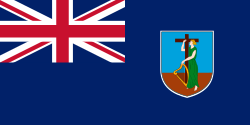Culture and influence
The remains of Irish culture in Montserrat are evident in modern times. This can be seen in the island's flag and coat of arms which portrays a woman with a harp and cross. Montserrat's national emblem is an Irish shamrock adorning Government house, again associated with the traditional Irish shamrock. The shamrock also appears in passport and postage stamps, as well as tourist-related buildings and signage. [10] Other cultural influences include music, value systems, and the Irish recipe for the national dish "goat water stew." In 2002, Montserrat introduced their national dress, an "Irish tartan," that is green, gold and white, evoking both their Irish and African cultural heritage. [10] [11] The spoken language of the island is English and the native inhabitants of Montserrat speak with a hint of an Irish accent.

St. Patrick's Day
Identified as a national holiday in Montserrat, Saint Patrick's Day is a week long festival celebrated every year since 1985. [12] The true meaning of the celebration is a bit controversial. In its beginnings, Saint Patrick's Day was meant as a day spent in celebration of the 1768 uprising by the enslaved and the free communities against the oppression and poverty suffered at the hands of the wealthy Anglo-Irish plantation owners. March 17 can also be called "Heroes Day," due to Sir Howard A. Fergus' work in popularizing the uprising. [11] Today, it is celebrated more as the traditional Irish Saint Patrick's Day. [10] Along with traditional Caribbean entertainment, the festival also provides a rich mix of African and Irish heritage. Many typical Irish images are displayed, such as shamrocks, leprechauns, and Guinness beer, but African heritage is included in the incorporation of dance and music into celebrations, as well as certain events such as the "Slave Feast." [11] This Irish celebration in Montserrat is promoted as a tourist attraction, and represents an economic opportunity by attracting members of the Irish diaspora to the island for the celebrations. [11] [10]